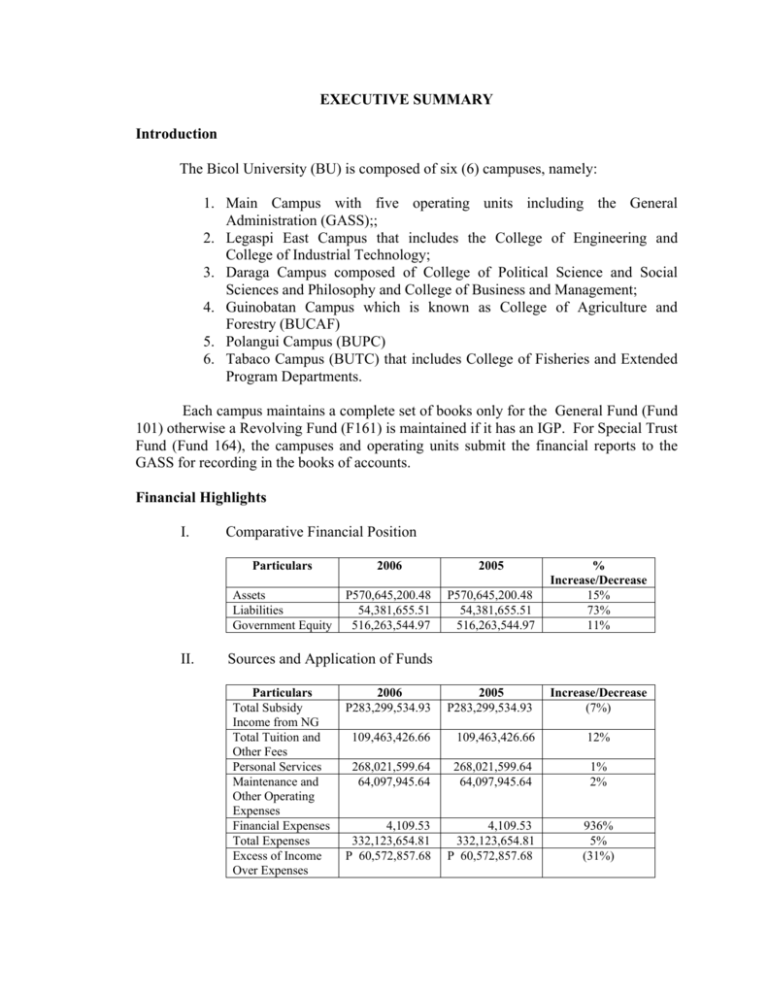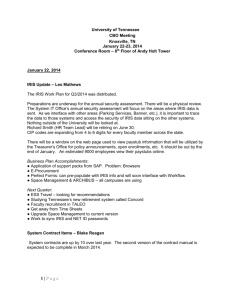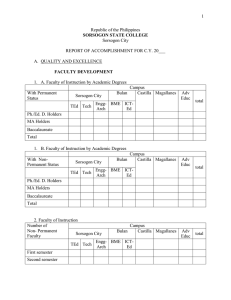View PDF
advertisement

EXECUTIVE SUMMARY Introduction The Bicol University (BU) is composed of six (6) campuses, namely: 1. Main Campus with five operating units including the General Administration (GASS);; 2. Legaspi East Campus that includes the College of Engineering and College of Industrial Technology; 3. Daraga Campus composed of College of Political Science and Social Sciences and Philosophy and College of Business and Management; 4. Guinobatan Campus which is known as College of Agriculture and Forestry (BUCAF) 5. Polangui Campus (BUPC) 6. Tabaco Campus (BUTC) that includes College of Fisheries and Extended Program Departments. Each campus maintains a complete set of books only for the General Fund (Fund 101) otherwise a Revolving Fund (F161) is maintained if it has an IGP. For Special Trust Fund (Fund 164), the campuses and operating units submit the financial reports to the GASS for recording in the books of accounts. Financial Highlights I. II. Comparative Financial Position Particulars 2006 2005 Assets Liabilities Government Equity P570,645,200.48 54,381,655.51 516,263,544.97 P570,645,200.48 54,381,655.51 516,263,544.97 % Increase/Decrease 15% 73% 11% 2006 P283,299,534.93 2005 P283,299,534.93 Increase/Decrease (7%) 109,463,426.66 109,463,426.66 12% 268,021,599.64 64,097,945.64 268,021,599.64 64,097,945.64 1% 2% 4,109.53 332,123,654.81 P 60,572,857.68 4,109.53 332,123,654.81 P 60,572,857.68 936% 5% (31%) Sources and Application of Funds Particulars Total Subsidy Income from NG Total Tuition and Other Fees Personal Services Maintenance and Other Operating Expenses Financial Expenses Total Expenses Excess of Income Over Expenses Operational Highlights Instruction The first year students admitted in June, 2006 for SY 2006-2007 totaled 4,077 out of the 11,356 who took the entrance test posting a decrease of 466 or 10.26% as compared with the previous school year of 4,543. One of the reasons was the inavailability of slots for those seeking admission in popular courses like BS in Nursing and Accountancy. Over the five year period, from SY 2002-2003 to 2005-2006, enrolment in tertiary education programs in the University has progressively increased, decreased in the graduate levels, and reduced deliberately in basic education. For SY 2006-2007, enrolment in tertiary education (15,955) increased by 1.2% or 190 over that of SY 2005-2006 (15,765). Enrolment in the graduate level teacher education program is greater in percentage (374 or 50%) than in the corresponding undergraduate level program. The reduction in the enrollment at the basic education level is in keeping with the 500-student enrolment limit set by the DBM for laboratory schools in state colleges and universities. The March 2006 graduates of Bicol University totaled 2,682 distributed as follows: 46 in the graduate level; 2,356 in the baccalaureate level; 68 in the certificate program; and 212 in basic education. This total number is 149 or 3.95% more than the March, 2005 graduates of 2,533. Of this graduates, 125 (5.31%) graduated with honors. Accreditation The Colleges of Education and Fisheries have obtained CHED Center of Excellence status for their programs, while the College of Science has recently applied for Center of Development Status. Performance in Licensure Examination The performance of BU Graduates in various licensure examinations speak of the quality of instruction they receive. For the CPA examination conducted in May, 2006, out of 9 examinees, six passed or 67% passers as against the National percentage of 24% while for the Architect Licensure, 16 passed the board exam out of the 28 examinees or 57% as compared with the national percentage of 43%. Scope of Audit The audit was aimed to ascertain the fairness and reliability of the agency’s financial position and the results of its operations. The audit conducted included examining, on a test basis, evidence supporting the amounts and disclosures in the financial statements. The audit was for the period January to December 31, 2006. Auditor’s Report The auditor issued an adverse opinion on the fairness of the presentation of the financial statements because the validity, accuracy and reliability of the balances of the Cash-inBank Local Currency Account amounting to P73,243,481.40 could not be ascertained due to inadequacy of available records and some deficiencies in the preparation/maintenance of records and reports required under existing regulations. Likewise, the validity, accuracy and existence of the Inventory accounts and Property, Plant and Equipment accounts totaling P57,719,169.63 and P323,692,979.15, representing 10% and 55%, respectively, of the total assets, could not be ascertained because of management’s failure to conduct complete physical inventory, prepare the required accounting and property records and accordingly reconcile the balances of the accounts with the results of the physical count. Significant Observations and Recommendations 1. Delayed implementation of approved activities ranging from two to five months as Commission on Higher Education’s (CHED) identified Center of Excellence pursuant to Republic Act 8435 for want of insights on financial management as well as its weak monitoring of activities resulted in unutilized funds amounting to P1,458,930.40 representing 33% of the total CHED Subsidy of P4.5M. We recommend that the university: ¾ Prioritize time-bounded undertakings/projects/activities ¾ Adequately orient project implementers not only on the project but including financial management ¾ Regularly conduct assessment or review of project implementation in order to ensure timely completion of the undertaking and identification of issues and concerns that would hinder the success of the project. 2. Absence of guidelines and lack of monitoring on research outputs costing P134,992.66 as required in Section O of the Manual of Operation for Research resulted in the failure to attain the project’s viability and could result to infringement of intellectual property rights. We recommend that the University fast track the development of guidelines on Intellectual Property Rights. Implementation of Prior Year’s Recommendations Of last year’s 24 audit recommendations, seven or 29% were fully implemented, six or 12% were partially implemented and fourteen or 58% were not implemented.







